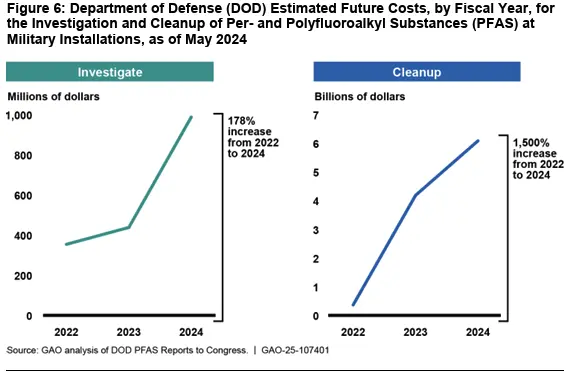WASHINGTON, D.C. – The U.S. Department of Defense has quietly extended the timeline to clean up “forever chemicals” at more than 100 military sites around the country, including Montana’s largest military outpost.
Malmstrom Air Force Base in Great Falls is among 140 military sites with a delayed investigations and remediation timeline for chemicals known as PFAS — perfluoroalkyl and polyfluoroalkyl substances — which can take thousands of years to break down and can be present in water, soil and even food.
The chemicals are found in waterproofing material, food packaging and in fire-fighting foam. The last source, used in emergency response training at airports and military bases, makes the Department of Defense one of the most prolific users of the chemicals.
Studies have linked exposure to the chemicals with increased risks of cancer, immune disorders, problems with child development, and other adverse health effects, according to an EPA health advisory.

The Defense Department has identified more than 700 military installations where PFAS was used or may have been released. Since 2017, the Department has spent $2.6 billion investigating and cleaning up the substances, according to a recent report to Congress.
A spokesperson for Malmstrom could not immediately address Friday the extent of the cleanup that’s needed at the base. He estimated the population at the base to be from 4,000 to 5,000 people based on residential units and dorms.
The delays to cleanup timelines were first reported by the New York Times on Tuesday. The Times cross-checked a list of contaminated sites, only publicly released by the Pentagon in recent weeks, with a timetable released in December 2024, in the final days of the Biden administration. Roughly 140 sites have listed dates to complete preparatory work and begin cleanup pushed back several years.
The Daily Montanan’s analysis of a progress report from Sept. 30, 2024, found that Malmstrom was slated to have its remedial investigation and feasibility study completed by September 2026. That date has now shifted to June 2032, according to the departments’s new progress report.
Estimated dates for two U.S. Army locations — Helena’s Fort William Henry Harrison and Helena Aviation Readiness Center — to investigate and complete feasibility studies for cleanup have not changed, with investigation and feasibility studies estimated to end in March of 2026 and September of 2028 respectively.
Nolan Lister, a spokesperson for the Montana Department of Environmental Quality, said work on the Comprehensive Environmental Response, Compensation, and Liability Act (CERCLA) process at Malmstrom is currently in the remedial investigation phase, and confirmed that the process has been extended for five more years, a decision that is “supported by DEQ.”
Lister said that the report is expected to be submitted to DEQ in Spring 2026, and that data will then be incorporated into a feasibility study to determine the best actions for remediation.
While no clean-up has yet been completed at the base, Lister said “best management practices” have been implemented to reduce PFAS in stormwater discharges and a “sundown” of aqueous film-forming foam in fire suppression systems. Fire and emergency vehicles are also in the process of switching to a fluorine-free foam, Lister added.
“The Air Force has contracts in place to properly dispose of all (aqueous film-forming foam) collected from hangars and vehicles by end of 2025,” Lister wrote in an email. “In addition, at known (foam) release sites, any construction projects are required to coordinate with remedial project managers, and PFAS-contaminated soil is managed to minimize runoff. Any PFAS-impacted groundwater from dewatering is required to be treated or disposed appropriately as well.”

The New York Times reported that while the delays in site-specific cleanup operations were announced quietly, it comes amid debates about the 2026 National Defense Authorization Act, which in its current form would undo a ban on purchasing and using firefighting foam made with PFAS and shrink funding for toxic site cleanups.
However, the NDAA also contains provisions to “accelerate remediation” of PFAS-contaminated sites, and provides for the department to create a publicly available online dashboard to track response efforts at each military installation.
According to a 2025 Government Accountability Office report to congress on PFAS cleanup, the Department of Defense, referred to by the Trump administration as the “Department of War,” says that costs for investigation and cleanup have skyrocketed.
“The department’s estimated future PFAS investigation costs more than tripled since 2022, while estimates for future pFAS cleanup costs have increased 15-fold,” the report states.
Lister, with Montana DEQ, said the department is “not aware of any funding delays regarding our PFAS investigations at Malmstrom or the Great Falls National Guard site,” but that if funds were shifted away from remediation efforts it could “slow progress along the CECRLA path, resulting in additional time passing before implementation of cleanup.”
“The Department of War has not communicated any potential funding delay,” Lister said.
In a statement, Pentagon Press Secretary Kingsley Wilson said the Department of War “committed to addressing PFAS and remains transparent about the Department’s efforts to identify locations where PFAS may have been released into the environment due to previous defense activities. The Department’s timeline for cleanup is dictated by the cleanup law (i.e., CERCLA) and its regulations, and reflects both an evolving understanding of PFAS conditions at our military installations and additional investigation based on drinking water standards that EPA finalized last year.”
“The Department will continue to follow the law, work with regulatory agencies, engage with affected communities, and prioritize actions to address cleanup at locations that pose the greatest risk to human health,” Wilson said.

At the Montana Air National Guard Base in Great Falls, also listed on the DOD list of contaminated sites, remedial investigation work was expected to begin in September. Lister said that the remedial investigation is planned and “will be sequenced for funding alongside other ANG and Air Force enterprise-wide locations.”
The state’s cleanup efforts are funded through the Defense and State Memorandum of Agreement program on a two-year funding cycle.
“DEQ is currently working through the process of generating work plans known as Joint Execution Plans with our federal partners for work that will be conducted 2027 to 2032,” Lister added.
The U.S. Environmental Protection Agency in 2024 released new drinking water standards for certain PFAS compounds. The Montana Department of Environmental Quality says they are still reviewing the new information and will look to adopt the standards into rule during a two-year process.
According to EPA’s new recently released standards, public water supplies have three years to meet the PFAS sampling requirements and then two additional years to implement a remedy if the water quality results exceed the new standards.
The Department of Environmental Quality has sampled public water systems in Montana for PFAS contamination in recent years. Only one location, in Kalispell, was found to exceed EPA advisory levels.
This article has been updated with a statement from the Department of War.
Daily Montanan is part of States Newsroom, a nonprofit news network supported by grants and a coalition of donors as a 501c(3) public charity. Daily Montanan maintains editorial independence. Contact Editor Darrell Ehrlick for questions: info@dailymontanan.com.





